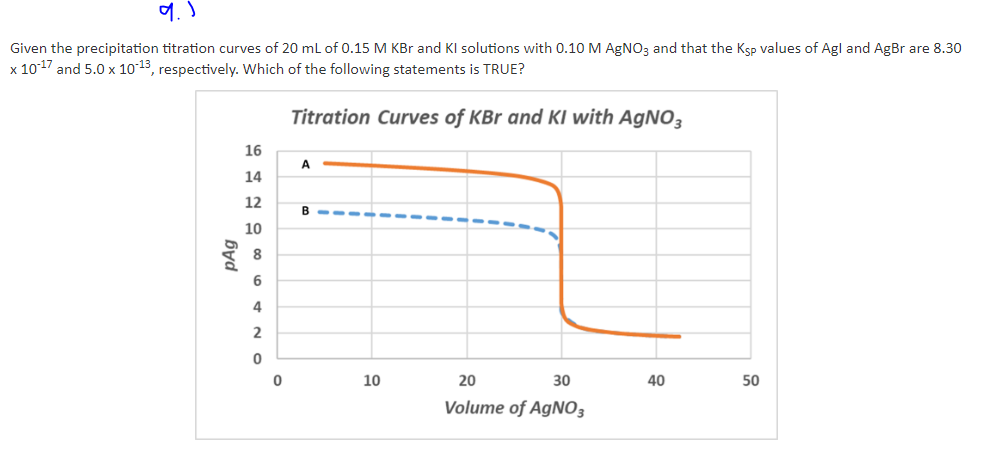OA.The two species cannot be separated by titration. OB.Curve A and B represents the titration of AgBr and Agl, respectively. C. Curve A and B represents the titration of Agl and AgBr, respectively. OD. AgBr will precipitate second.
OA.The two species cannot be separated by titration. OB.Curve A and B represents the titration of AgBr and Agl, respectively. C. Curve A and B represents the titration of Agl and AgBr, respectively. OD. AgBr will precipitate second.
Chemistry: Principles and Practice
3rd Edition
ISBN:9780534420123
Author:Daniel L. Reger, Scott R. Goode, David W. Ball, Edward Mercer
Publisher:Daniel L. Reger, Scott R. Goode, David W. Ball, Edward Mercer
Chapter16: Reactions Between Acids And Bases
Section: Chapter Questions
Problem 16.24QE: Calculate the pH during the titration of 50.00 mL of 0.100 M Sr(OH)2 with 0.100 M HNO3 after 0,...
Related questions
Question

Transcribed Image Text:9.1
Given the precipitation titration curves of 20 mL of 0.15 M KBr and KI solutions with 0.10 M AgNO3 and that the Ksp values of Agl and AgBr are 8.30
x 10-17 and 5.0 x 10-13, respectively. Which of the following statements is TRUE?
Titration Curves of KBr and KI with AgNO3
pAg
16
14
12
10
8
6
4
2
0
0
A
10
20
30
Volume of AgNO3
40
50

Transcribed Image Text:O A.The two species cannot be separated by titration.
B.Curve A and B represents the titration of AgBr and Agl, respectively.
O C. Curve A and B represents the titration of Agl and AgBr, respectively.
O D. AgBr will precipitate second.
Expert Solution
This question has been solved!
Explore an expertly crafted, step-by-step solution for a thorough understanding of key concepts.
Step by step
Solved in 2 steps with 1 images

Knowledge Booster
Learn more about
Need a deep-dive on the concept behind this application? Look no further. Learn more about this topic, chemistry and related others by exploring similar questions and additional content below.Recommended textbooks for you

Chemistry: Principles and Practice
Chemistry
ISBN:
9780534420123
Author:
Daniel L. Reger, Scott R. Goode, David W. Ball, Edward Mercer
Publisher:
Cengage Learning

General Chemistry - Standalone book (MindTap Cour…
Chemistry
ISBN:
9781305580343
Author:
Steven D. Gammon, Ebbing, Darrell Ebbing, Steven D., Darrell; Gammon, Darrell Ebbing; Steven D. Gammon, Darrell D.; Gammon, Ebbing; Steven D. Gammon; Darrell
Publisher:
Cengage Learning

Chemistry & Chemical Reactivity
Chemistry
ISBN:
9781337399074
Author:
John C. Kotz, Paul M. Treichel, John Townsend, David Treichel
Publisher:
Cengage Learning

Chemistry: Principles and Practice
Chemistry
ISBN:
9780534420123
Author:
Daniel L. Reger, Scott R. Goode, David W. Ball, Edward Mercer
Publisher:
Cengage Learning

General Chemistry - Standalone book (MindTap Cour…
Chemistry
ISBN:
9781305580343
Author:
Steven D. Gammon, Ebbing, Darrell Ebbing, Steven D., Darrell; Gammon, Darrell Ebbing; Steven D. Gammon, Darrell D.; Gammon, Ebbing; Steven D. Gammon; Darrell
Publisher:
Cengage Learning

Chemistry & Chemical Reactivity
Chemistry
ISBN:
9781337399074
Author:
John C. Kotz, Paul M. Treichel, John Townsend, David Treichel
Publisher:
Cengage Learning

Chemistry & Chemical Reactivity
Chemistry
ISBN:
9781133949640
Author:
John C. Kotz, Paul M. Treichel, John Townsend, David Treichel
Publisher:
Cengage Learning

